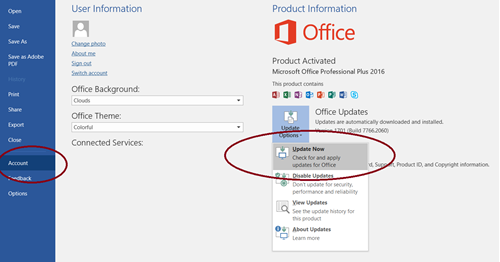Elevating Productivity: A Comprehensive Guide on How to Upgrade Microsoft Office

Introduction:
Microsoft Office stands as a cornerstone in the realm of productivity tools, empowering individuals and businesses with a suite of applications that facilitate document creation, data analysis, and collaboration. Regularly upgrading Microsoft Office ensures access to the latest features, security patches, and improvements, enhancing user experience and safeguarding against potential vulnerabilities. This comprehensive guide aims to demystify the process of upgrading Microsoft Office, providing step-by-step instructions and insights into the various aspects of the upgrade journey.
Chapter 1: Understanding the Need for Microsoft Office Upgrades
Before delving into the specifics of upgrading Microsoft Office, it’s essential to comprehend the reasons behind the need for upgrades. This chapter will explore the importance of staying current with software updates, including security considerations, feature enhancements, compatibility improvements, and the overall optimization of performance. Recognizing the benefits of upgrades sets the stage for a proactive approach to maintaining a cutting-edge productivity suite.
Chapter 2: Identifying Your Current Microsoft Office Version
A crucial first step in the upgrade process is identifying the current version of Microsoft Office installed on your system. This chapter will guide you through the steps to determine your Office version, whether it’s Office 2013, Office 2016, Office 2019, or a Microsoft 365 subscription. Knowing your current version is crucial for selecting the appropriate upgrade path.
Chapter 3: Microsoft 365 Subscription vs. Perpetual License
Microsoft offers two main licensing models for Office: Microsoft 365 subscriptions and perpetual licenses. This chapter will explore the differences between these models, including subscription-based access to Microsoft 365’s cloud-based services and the traditional one-time purchase of perpetual licenses. Understanding the distinctions helps you make informed decisions about your upgrade strategy.
Chapter 4: Choosing the Right Microsoft 365 Plan
For those opting for a Microsoft 365 subscription, choosing the right plan is essential. This chapter will guide you through the available Microsoft 365 plans, such as Business, Enterprise, or Personal, highlighting their features, pricing, and suitability for different user needs. Selecting the right plan ensures that you have access to the tools and services that align with your requirements.
Chapter 5: System Requirements for Microsoft Office Upgrades
Before initiating an upgrade, it’s crucial to ensure that your system meets the necessary requirements. This chapter will outline the system specifications for different versions of Microsoft Office, covering operating system compatibility, processor requirements, RAM, and disk space. Verifying system compatibility is essential for a smooth and successful upgrade process.
Chapter 6: Backing Up Your Data Before the Upgrade
As a precautionary measure, it’s advisable to back up your data before proceeding with any software upgrade. This chapter will guide you through the steps to back up important documents, settings, and email data to prevent data loss during the upgrade process. Implementing thorough backups provides peace of mind and ensures that your critical information remains secure.
Chapter 7: Uninstalling Previous Versions of Microsoft Office
To pave the way for a clean and efficient upgrade, it’s recommended to uninstall previous versions of Microsoft Office. This chapter will provide step-by-step instructions on uninstalling Office versions from your computer, ensuring that there are no conflicts or compatibility issues with the new installation. A clean uninstallation is a crucial preparatory step for a successful upgrade.
Chapter 8: Downloading and Installing Microsoft Office
Once you’ve prepared your system, the next step is to download and install the upgraded version of Microsoft Office. This chapter will guide you through the process, covering the official Microsoft website, installation options, and customizing your installation settings. Following the correct installation steps ensures a seamless transition to the latest Office version.
Chapter 9: Activating Your Microsoft Office Subscription
For users opting for a Microsoft 365 subscription, activating your Office suite is a necessary step. This chapter will walk you through the activation process, including entering your product key or signing in with your Microsoft account. Activating your subscription ensures that you can fully utilize the features and benefits of the upgraded Office suite.
Chapter 10: Exploring New Features in Microsoft Office
Each Microsoft Office upgrade introduces new features and enhancements designed to improve productivity and user experience. This chapter will explore some of the notable features in recent Office versions, including intelligent collaboration tools, advanced data analysis capabilities, and enhanced security features. Familiarizing yourself with new features allows you to leverage the full potential of the upgraded suite.
Chapter 11: Configuring Microsoft Office Settings
Optimizing your Microsoft Office settings according to your preferences is a crucial post-upgrade step. This chapter will guide you through configuring settings such as default document formats, privacy preferences, and collaboration options. Tailoring your settings ensures that the upgraded Office suite aligns with your workflow and user preferences.
Chapter 12: Troubleshooting Common Upgrade Issues
Despite careful preparations, users may encounter common issues during the upgrade process. This chapter will address potential challenges such as installation errors, activation issues, and compatibility concerns. Troubleshooting tips and solutions will be provided to help users navigate and resolve common upgrade issues effectively.
Chapter 13: Microsoft Office Update Cadence
Microsoft follows a regular update cadence to continuously enhance and secure the Office suite. This chapter will explore the update schedules for Microsoft 365 subscribers and users of perpetual licenses, including the release of security updates, feature improvements, and bug fixes. Staying informed about update cycles ensures that your Office suite remains current and optimized.
Chapter 14: Integrating Microsoft Office with Cloud Services
Microsoft Office seamlessly integrates with cloud services, enabling enhanced collaboration, accessibility, and data storage. This chapter will explore the integration of Office with cloud platforms like OneDrive and SharePoint, allowing users to leverage cloud-based features for file storage, sharing, and real-time collaboration. Integrating cloud services enhances the versatility of the upgraded Office suite.
Chapter 15: Microsoft Office Mobile Apps
In the era of mobile productivity, Microsoft offers mobile apps that complement the desktop suite. This chapter will explore the Microsoft Office mobile apps, available for iOS and Android devices, providing users with on-the-go access to Word, Excel, PowerPoint, and other Office applications. Integrating mobile apps into your workflow enhances flexibility and productivity.
Chapter 16: Best Practices for Ongoing Office Management
Successfully upgrading Microsoft Office is just the beginning. This chapter will delve into best practices for ongoing Office management, including regularly checking for updates, optimizing system performance, and staying informed about new features. Adopting best practices ensures that your Office suite remains a reliable and efficient tool for your professional endeavors.
Chapter 17: Training and Resources for Office Users
To empower users with the full capabilities of the upgraded Office suite, this chapter will highlight training resources and support channels provided by Microsoft. Whether through official tutorials, online courses, or community forums, accessing training materials ensures that users can harness the power of Microsoft Office to its fullest extent.
Chapter 18: Future Trends in Microsoft Office
The landscape of productivity tools is dynamic, with emerging trends shaping the future of Microsoft Office. This chapter will explore potential future trends, such as enhanced AI integration, augmented reality features, and further collaboration capabilities. Staying abreast of future trends prepares users for upcoming advancements in the Microsoft Office ecosystem.
Chapter 19: Real-Life Office Upgrade Experiences
To provide practical insights, this chapter will showcase real-life experiences of individuals and businesses that have successfully navigated the Microsoft Office upgrade journey. Examining these experiences offers valuable lessons, tips, and inspiration for users embarking on their own upgrade endeavors.
Conclusion:
Upgrading Microsoft Office is a proactive step toward harnessing the latest innovations in productivity tools. This comprehensive guide has equipped you with the knowledge and insights needed to successfully navigate the upgrade process, whether you’re transitioning to a Microsoft 365 subscription or updating a perpetual license. Whether you’re an individual user, a business professional, or an IT administrator, may this guide serve as a valuable companion on your journey to elevating your productivity with the latest version of Microsoft Office.







